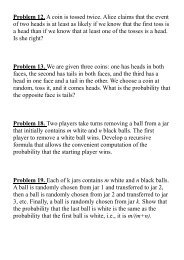1. Alice and Bob alternate playing at the casino table. (Alice starts ...
1. Alice and Bob alternate playing at the casino table. (Alice starts ...
1. Alice and Bob alternate playing at the casino table. (Alice starts ...
- No tags were found...
You also want an ePaper? Increase the reach of your titles
YUMPU automatically turns print PDFs into web optimized ePapers that Google loves.
<strong>1.</strong> <strong>Alice</strong> <strong>and</strong> <strong>Bob</strong> <strong>altern<strong>at</strong>e</strong> <strong>playing</strong> <strong>at</strong> <strong>the</strong> <strong>casino</strong> <strong>table</strong>. (<strong>Alice</strong> <strong>starts</strong><strong>and</strong> plays <strong>at</strong> odd times i =1, 3, . . . ; <strong>Bob</strong> plays <strong>at</strong> even times i = 2,4, . . ..) At each time i, <strong>the</strong> net gain of whoever is <strong>playing</strong> is ar<strong>and</strong>om variable Gi with <strong>the</strong> following PMF:P G (g){1, g = −2312 , g = 116 , g = 30 , o<strong>the</strong>rwiseAssume th<strong>at</strong> <strong>the</strong> net gains <strong>at</strong> different times are independent. Werefer to an outcome of -2 as a “loss.”(a) They keep gambling until <strong>the</strong> first time where a loss by <strong>Bob</strong>immedi<strong>at</strong>ely follows a loss by <strong>Alice</strong>. Write down <strong>the</strong> PMF of <strong>the</strong>total number of rounds played. (A round consists of two plays,one by <strong>Alice</strong> <strong>and</strong> <strong>the</strong>n one by <strong>Bob</strong>.)(b) Write down <strong>the</strong> PMF for Z, defined as <strong>the</strong> time <strong>at</strong> which <strong>Bob</strong> hashis third loss.(c) Let N be <strong>the</strong> number of rounds until each one of <strong>the</strong>m has won<strong>at</strong> least once. Find E(N).Solution(a)For each round, <strong>the</strong> probability th<strong>at</strong> <strong>Alice</strong> <strong>and</strong> <strong>Bob</strong> both have a loss is 1 9 .Let r<strong>and</strong>om variable X represent <strong>the</strong> total number of rounds played until<strong>the</strong> first time where <strong>the</strong>y both have a loss. Then X is a geometric r<strong>and</strong>omvariable with parameter p = 1 9<strong>and</strong> has <strong>the</strong> following PMF.p X (x) = (1 − p) x−1 p = ( 8 x−19 ) ( 1 ) , x = 1,2, …9
(b)Consider <strong>the</strong> number of games M <strong>Bob</strong> played until his third loss.p M (m) = ( m − 1 33 − 1 ) (1 3 ) ( 2 m−33 ) , m = 3,4,5, …We define <strong>the</strong> o<strong>the</strong>r r<strong>and</strong>om variable Z as <strong>the</strong> time <strong>at</strong> which <strong>Bob</strong> has histhird loss. Z = 2M. By changing variables, we obtainzp Z (z) = ( 2 − 133 − 1 ) (1 3 ) ( 2 z3 ) 2 −3 , z = 6,8,10, …(c)Consider <strong>the</strong> following partitionA 1 : both win first roundA 2 : only <strong>Alice</strong> wins first roundA 3 : only <strong>Bob</strong> wins first roundA 4 : both lose first roundE[N] = E[N|A 1 ]P(A 1 ) + E[N|A 2 ]P(A 2 ) + E[N|A 3 ]P(A 3 )+ E[N|A 4 ]P(A 4 )E[N] = 1 ∙ ( 2 3 ∙ 2 3 ) + (1 + 1 ) ∙ ( 1 2 3 ∙ 2 3 ) ∙ 2 + (1 + E[N]) ∙ (1 3 ∙ 1 3 )3E[N] = 158



